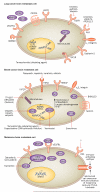Current approaches to the treatment of metastatic brain tumours
- PMID: 24569448
- PMCID: PMC4041037
- DOI: 10.1038/nrclinonc.2014.25
Current approaches to the treatment of metastatic brain tumours
Abstract
Metastatic tumours involving the brain overshadow primary brain neoplasms in frequency and are an important complication in the overall management of many cancers. Importantly, advances are being made in understanding the molecular biology underlying the initial development and eventual proliferation of brain metastases. Surgery and radiation remain the cornerstones of the therapy for symptomatic lesions; however, image-based guidance is improving surgical technique to maximize the preservation of normal tissue, while more sophisticated approaches to radiation therapy are being used to minimize the long-standing concerns over the toxicity of whole-brain radiation protocols used in the past. Furthermore, the burgeoning knowledge of tumour biology has facilitated the entry of systemically administered therapies into the clinic. Responses to these targeted interventions have ranged from substantial toxicity with no control of disease to periods of useful tumour control with no decrement in performance status of the treated individual. This experience enables recognition of the limits of targeted therapy, but has also informed methods to optimize this approach. This Review focuses on the clinically relevant molecular biology of brain metastases, and summarizes the current applications of these data to imaging, surgery, radiation therapy, cytotoxic chemotherapy and targeted therapy.
Figures

References
-
- US Census Bureau Census.gov [online] 2010 http://www.census.gov/prod/cen2010/briefs/c2010br-01.pdf.
-
- Fox BD, Cheung VJ, Patel AJ, Suki D, Rao G. Epidemiology of metastatic brain tumors. Neurosurg. Clin. N. Am. 2011;22:1–6. - PubMed
-
- Nieder C, Spanne O, Mehta MP, Grosu AL, Geinitz H. Presentation, patterns of care, and survival in patients with brain metastases: what has changed in the last 20 years? Cancer. 2011;117:2505–2512. - PubMed
-
- Schouten LJ, Rutten J, Huveneers HA, Twijnstra A. Incidence of brain metastases in a cohort of patients with carcinoma of the breast, colon, kidney, and lung and melanoma. Cancer. 2002;94:2698–2705. - PubMed
Publication types
MeSH terms
Substances
Grants and funding
LinkOut - more resources
Full Text Sources
Other Literature Sources
Medical
Molecular Biology Databases
Miscellaneous

